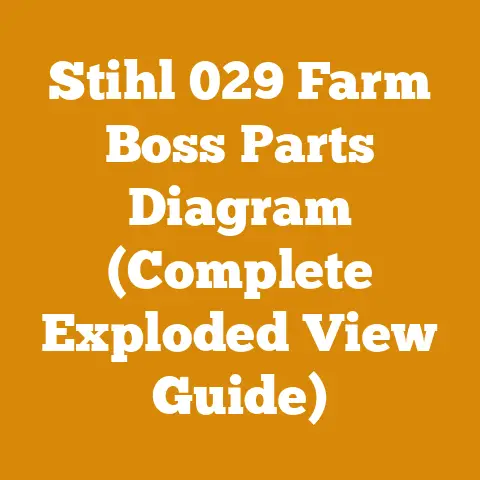Echo EVL Chainsaw Guide (5 Expert Tips for Woodworkers)
Echo EVL Chainsaw Guide: 5 Expert Tips for Woodworkers
The Echo EVL chainsaw. For years, it’s been a workhorse in my arsenal, a testament to durability in the demanding world of wood processing. I’ve seen it fell towering oaks, buck hefty logs, and even help carve intricate designs – all while maintaining its reliable performance. This guide isn’t just a collection of facts; it’s a distillation of my own experiences, the lessons I’ve learned, and the tricks I’ve picked up over countless hours working with the Echo EVL. I aim to provide you with actionable strategies to maximize your chainsaw’s potential, whether you’re a seasoned woodworker or just starting out.
1. Mastering Chainsaw Maintenance: The Lifeline of Your Echo EVL
A well-maintained chainsaw is a safe and efficient chainsaw. Neglecting maintenance is like ignoring a ticking clock – eventually, something will break down, costing you time, money, and potentially leading to dangerous situations. I’ve seen too many woodworkers sidelined by preventable issues, and I want to help you avoid those pitfalls.
Sharpening Your Chainsaw Chain: The Key to Effortless Cutting
A dull chain is a dangerous chain. It requires more force to cut, increasing the risk of kickback and putting unnecessary strain on your chainsaw’s engine. I always sharpen my chain after every two tanks of fuel, or more frequently if I’m cutting dirty or abrasive wood.
- Tools You’ll Need: Chainsaw file (specific to your chain’s pitch), file guide, depth gauge tool, flat file, vise.
- Step-by-Step Sharpening Process:
- Secure the chainsaw bar in a vise.
- Use the file guide to maintain the correct angle (typically 30 degrees for the Echo EVL’s chain).
- File each cutter uniformly, removing only small amounts of metal with each stroke.
- Check and adjust the depth gauges with the depth gauge tool and flat file. The depth gauge should be approximately 0.025 inches below the cutter top plate.
- Pro Tip: I use a permanent marker to mark the starting cutter, ensuring I sharpen each one evenly.
Cleaning and Lubricating Your Echo EVL: Preventing Premature Wear
Dust, debris, and inadequate lubrication are silent killers of chainsaws. I make it a habit to thoroughly clean my Echo EVL after each use.
- Air Filter: Remove and clean the air filter regularly. I use compressed air to blow out debris, and occasionally wash it with warm, soapy water. Let it dry completely before reinstalling. A clogged air filter restricts airflow, leading to reduced power and potential engine damage.
- Bar and Chain: Clean the bar groove with a scraper or screwdriver to remove sawdust and debris. Check the bar for wear and burrs. Lubricate the chain regularly with high-quality bar and chain oil. I prefer a synthetic oil for its superior lubrication and reduced environmental impact. Adjust the oiler to ensure adequate lubrication – the chain should be throwing off a fine mist of oil while cutting.
- Spark Plug: Inspect the spark plug periodically. A fouled or worn spark plug can cause starting problems and poor performance. Replace it as needed. I typically replace mine every season.
Fueling Your Echo EVL: The Right Mix for Optimal Performance
Using the correct fuel mixture is crucial for the longevity of your two-stroke engine. I always use a high-quality two-stroke oil mixed at a ratio of 50:1 with fresh, high-octane gasoline.
- Mixing Fuel: Use a dedicated fuel container and accurately measure the oil and gasoline. Mix thoroughly before filling the chainsaw’s fuel tank.
- Fuel Storage: Store fuel in a cool, dry place away from direct sunlight. Fuel can degrade over time, leading to starting problems and engine damage. I never use fuel that’s been stored for more than 30 days.
- Ethanol Concerns: Be aware of the potential problems associated with ethanol-blended gasoline. Ethanol can absorb water, which can corrode fuel system components and cause engine damage. If possible, use ethanol-free gasoline. If you must use ethanol-blended fuel, add a fuel stabilizer to help prevent water absorption.
Takeaway: Consistent maintenance is an investment in the longevity and performance of your Echo EVL. By following these simple steps, you can prevent costly repairs and ensure your chainsaw is always ready to tackle your next project. Next, we’ll delve into optimizing your cutting techniques.
2. Optimizing Cutting Techniques: Precision and Efficiency with Your Echo EVL
Knowing how to wield your Echo EVL effectively is just as important as maintaining it. Improper cutting techniques can lead to wasted time, increased risk of injury, and damage to your chainsaw. I’ve learned through trial and error – and a few close calls – the importance of mastering these techniques.
Felling Trees Safely and Efficiently
Felling a tree is a serious undertaking that requires careful planning and execution. I always assess the tree and its surroundings before making any cuts.
- Assessing the Tree: Check for lean, dead limbs, and wind direction. Identify any obstacles that could interfere with the tree’s fall.
- Planning the Fall: Determine the desired direction of fall and clear a path for escape. I use a felling wedge to help guide the tree in the desired direction.
- Making the Cuts:
- Notch Cut: Cut a notch on the side of the tree facing the desired direction of fall. The notch should be about one-third of the tree’s diameter.
- Back Cut: Make the back cut on the opposite side of the tree, slightly above the notch. Leave a hinge of wood to control the fall.
- Felling Wedge: Insert a felling wedge into the back cut and drive it in to help push the tree over.
- Safety Precautions: Wear appropriate safety gear, including a helmet, eye protection, hearing protection, and chaps. Be aware of your surroundings and have a clear escape route.
Bucking Logs for Firewood: Efficient and Safe Practices
Bucking logs into firewood requires a different set of techniques than felling trees. I focus on maximizing efficiency and minimizing strain on my body.
- Proper Stance: Maintain a stable stance with your feet shoulder-width apart. Keep your back straight and bend at your knees.
- Log Support: Use a sawbuck or other support to elevate the log. This will make cutting easier and safer.
- Cutting Techniques:
- Overbucking: Cut from the top of the log down, stopping short of the bottom. Then, roll the log over and finish the cut from the other side.
- Underbucking: Cut from the bottom of the log up, stopping short of the top. Then, finish the cut from the top. I prefer overbucking for smaller logs and underbucking for larger logs.
- Avoiding Pinching: Be aware of the potential for the bar to get pinched in the cut. Use wedges to keep the cut open if necessary.
Limbing Techniques: Removing Branches Safely
Limbing is the process of removing branches from a felled tree. I always work from the base of the tree towards the top, keeping the trunk between me and the chainsaw.
- Tension and Compression: Be aware of the tension and compression in the branches. Branches under tension will spring back when cut, potentially causing injury. Branches under compression can pinch the bar.
- Cutting Techniques:
- Cutting on the Tension Side: Make a small cut on the tension side of the branch, followed by a cut on the compression side.
- Cutting on the Compression Side: Make a small cut on the compression side of the branch, followed by a cut on the tension side.
- Safety Precautions: Wear appropriate safety gear and be aware of your surroundings. Avoid cutting above your head.
Takeaway: Mastering these cutting techniques will not only make you a more efficient woodworker but also a safer one. By understanding the principles of felling, bucking, and limbing, you can minimize your risk of injury and maximize your productivity. Next, we’ll explore how to select the right bar and chain for your Echo EVL.
3. Selecting the Right Bar and Chain: Optimizing Your Echo EVL’s Performance
The bar and chain are the heart of your chainsaw’s cutting ability. Choosing the right ones for the job can significantly improve your efficiency and reduce wear and tear on your chainsaw. I’ve experimented with various combinations over the years and found what works best for different types of wood and cutting tasks.
Understanding Bar Length and Chain Pitch
Bar length refers to the length of the chainsaw bar, while chain pitch refers to the distance between the rivets on the chain. I select the bar length based on the diameter of the wood I’ll be cutting.
- Bar Length: A longer bar allows you to cut larger trees and logs, but it also requires more power. I typically use a 18-inch bar for my Echo EVL, which is a good compromise between power and maneuverability.
- Chain Pitch: The chain pitch must match the sprocket on your chainsaw. The Echo EVL typically uses a 3/8-inch or .325-inch pitch chain. I prefer a 3/8-inch pitch chain for its aggressive cutting ability.
Choosing the Right Chain Type
Different chain types are designed for different cutting applications. I use different chains depending on the type of wood I’m cutting and the desired cutting speed.
- Full Chisel Chain: Full chisel chains have square-cornered cutters that are very aggressive and fast-cutting. However, they are also more prone to damage from dirt and debris. I use full chisel chains for cutting clean, hardwood logs.
- Semi-Chisel Chain: Semi-chisel chains have rounded-corner cutters that are more durable and less prone to damage than full chisel chains. They are a good all-around choice for cutting a variety of wood types. I use semi-chisel chains for cutting dirty or softwood logs.
- Low-Kickback Chain: Low-kickback chains have features that reduce the risk of kickback. They are a good choice for beginners or anyone who is concerned about safety. I recommend using a low-kickback chain if you are new to chainsawing.
Matching Bar and Chain to Your Cutting Needs
The key is to match the bar and chain to the specific cutting task at hand. I always consider the type of wood, the size of the wood, and the desired cutting speed.
- Softwood vs. Hardwood: Softwood is easier to cut than hardwood, so you can use a more aggressive chain for softwood. Hardwood requires a more durable chain.
- Small vs. Large Wood: A shorter bar is sufficient for cutting small wood, while a longer bar is needed for cutting large wood.
- Cutting Speed: A full chisel chain will cut faster than a semi-chisel chain, but it is also more prone to damage.
Takeaway: Selecting the right bar and chain can significantly improve your Echo EVL’s performance and extend its lifespan. By understanding the different types of bars and chains available, you can choose the ones that are best suited for your specific cutting needs. Next, we’ll discuss essential safety gear and practices for chainsaw operation.
4. Prioritizing Safety: Essential Gear and Practices for Chainsaw Operation
Chainsaw operation is inherently dangerous. I can’t stress enough the importance of wearing appropriate safety gear and following safe operating procedures. I’ve witnessed firsthand the devastating consequences of neglecting safety, and I am committed to promoting safe chainsaw practices.
Essential Safety Gear: Protecting Yourself from Injury
Investing in high-quality safety gear is an investment in your well-being. I never operate a chainsaw without the following gear:
- Helmet: A helmet protects your head from falling debris and potential chainsaw kickback. I prefer a helmet with a face shield and hearing protection.
- Eye Protection: Safety glasses or a face shield protect your eyes from flying chips and debris.
- Hearing Protection: Chainsaws are loud, and prolonged exposure to high noise levels can damage your hearing. I use earplugs or earmuffs to protect my hearing.
- Chainsaw Chaps: Chainsaw chaps are designed to protect your legs from chainsaw cuts. They are made of multiple layers of ballistic nylon that will stop a chainsaw chain. I always wear chainsaw chaps when operating a chainsaw.
- Gloves: Gloves protect your hands from cuts and abrasions. I prefer gloves with a good grip.
- Steel-Toed Boots: Steel-toed boots protect your feet from falling logs and potential chainsaw cuts.
Safe Operating Practices: Minimizing the Risk of Accidents
Wearing safety gear is only part of the equation. I also follow safe operating procedures to minimize the risk of accidents.
- Read the Manual: Before operating your Echo EVL, read the owner’s manual and understand its safety features and operating instructions.
- Inspect Your Chainsaw: Before each use, inspect your chainsaw for any damage or worn parts. Make sure the chain is properly sharpened and tensioned.
- Clear the Work Area: Clear the work area of any obstacles, such as rocks, branches, and people.
- Maintain a Firm Grip: Always maintain a firm grip on the chainsaw with both hands.
- Keep Your Balance: Maintain your balance and avoid overreaching.
- Avoid Cutting Above Your Head: Cutting above your head is dangerous and should be avoided.
- Be Aware of Kickback: Kickback is a sudden, uncontrolled movement of the chainsaw bar that can cause serious injury. Be aware of the potential for kickback and take steps to avoid it.
- Never Cut Alone: Always work with someone else when operating a chainsaw.
- Take Breaks: Chainsaw operation can be physically demanding. Take frequent breaks to avoid fatigue.
Understanding and Avoiding Kickback
Kickback is one of the most common and dangerous chainsaw hazards. I make it a point to understand the different types of kickback and how to avoid them.
- Rotational Kickback: Rotational kickback occurs when the upper tip of the chainsaw bar contacts a solid object.
- Pinch Kickback: Pinch kickback occurs when the wood closes in on the chainsaw bar, pinching the chain.
- Pull-In: Pull-in occurs when the bottom of the chainsaw bar is used to cut and the chain catches on the wood, pulling the chainsaw forward.
- Avoiding Kickback:
- Avoid using the upper tip of the chainsaw bar.
- Keep the chain properly sharpened and tensioned.
- Use a low-kickback chain.
- Maintain a firm grip on the chainsaw.
- Be aware of your surroundings.
Takeaway: Safety should always be your top priority when operating a chainsaw. By wearing appropriate safety gear and following safe operating procedures, you can significantly reduce your risk of injury. Next, we’ll discuss troubleshooting common Echo EVL problems.
5. Troubleshooting Common Echo EVL Problems: Diagnosing and Resolving Issues
Even with proper maintenance and care, your Echo EVL may occasionally experience problems. Knowing how to diagnose and resolve common issues can save you time and money. I’ve encountered my fair share of chainsaw problems over the years, and I’ve learned how to troubleshoot them effectively.
Common Starting Problems
Starting problems are among the most frustrating issues you can encounter. I always start with the basics when troubleshooting starting problems.
- No Fuel: Make sure there is fuel in the tank.
- Fuel Mixture: Make sure the fuel mixture is correct (50:1).
- Spark Plug: Check the spark plug for fouling or damage. Clean or replace the spark plug as needed.
- Air Filter: Check the air filter for clogging. Clean or replace the air filter as needed.
- Carburetor: The carburetor may need to be adjusted or cleaned. If you’re not comfortable working on carburetors, take your chainsaw to a qualified repair shop.
Chain Problems
Chain problems can affect your chainsaw’s cutting performance and safety. I regularly inspect my chain for wear and damage.
- Dull Chain: Sharpen the chain regularly.
- Loose Chain: Adjust the chain tension. The chain should be snug on the bar but still able to be pulled around by hand.
- Chain Coming Off the Bar: This could be caused by a loose chain, a worn sprocket, or a damaged bar. Replace the worn or damaged parts.
- Insufficient Chain Lubrication: Check the oil level and make sure the oiler is working properly.
Engine Problems
Engine problems can range from minor annoyances to major breakdowns. I address engine problems promptly to prevent further damage.
- Loss of Power: This could be caused by a clogged air filter, a fouled spark plug, or a problem with the carburetor.
- Engine Stalling: This could be caused by a lean fuel mixture, a clogged fuel filter, or a problem with the carburetor.
- Excessive Smoke: This could be caused by an overly rich fuel mixture or a problem with the engine.
- Overheating: Overheating can be caused by a lean fuel mixture, a clogged air filter, or insufficient lubrication.
When to Seek Professional Help
While I encourage you to troubleshoot common problems yourself, there are times when it’s best to seek professional help. If you’re not comfortable working on your chainsaw, or if you’ve tried troubleshooting the problem and it’s still not resolved, take your chainsaw to a qualified repair shop. I’ve learned the hard way that some repairs are best left to the experts.
Takeaway: By understanding common Echo EVL problems and how to troubleshoot them, you can save time and money on repairs. However, don’t hesitate to seek professional help when needed.






